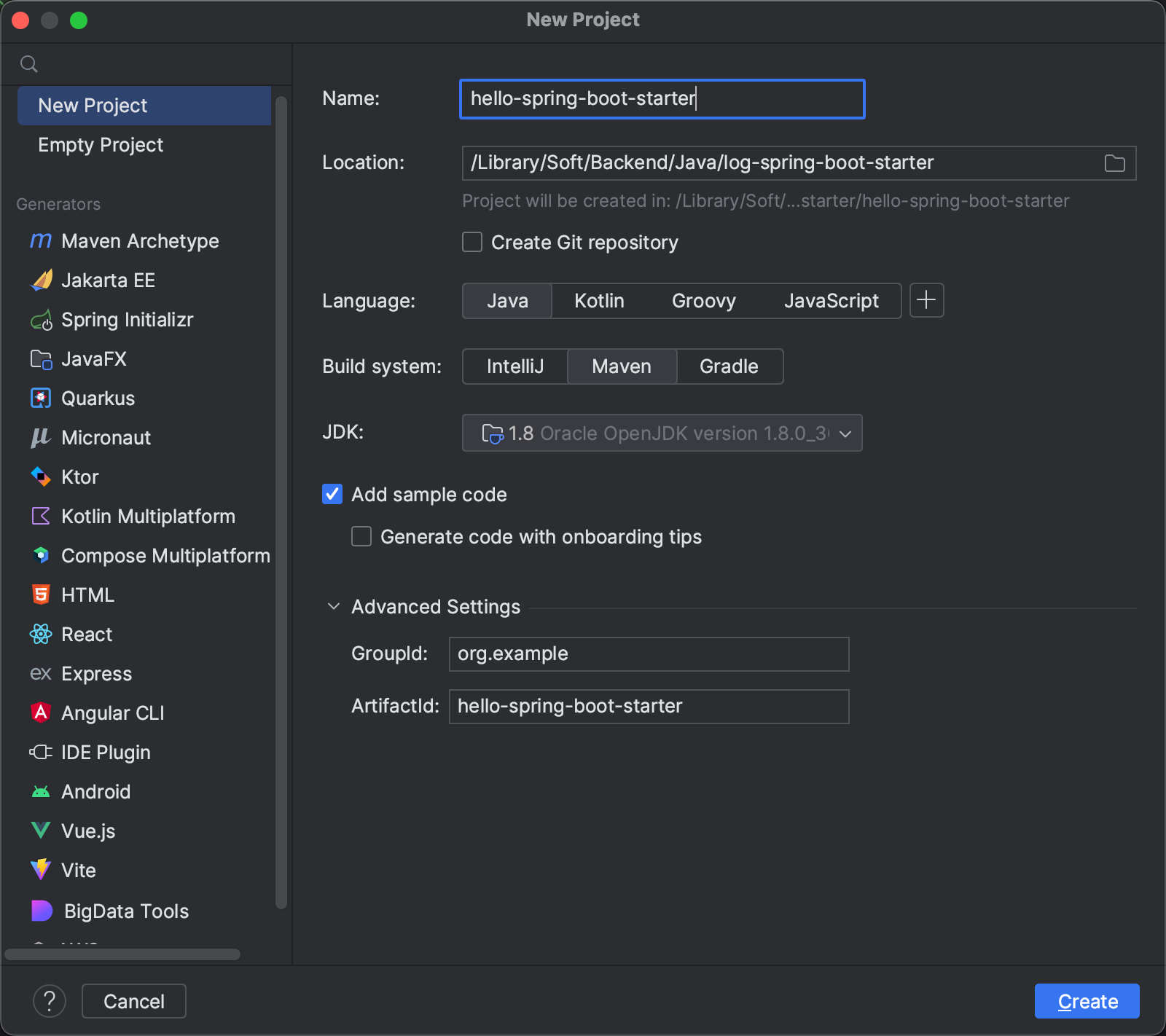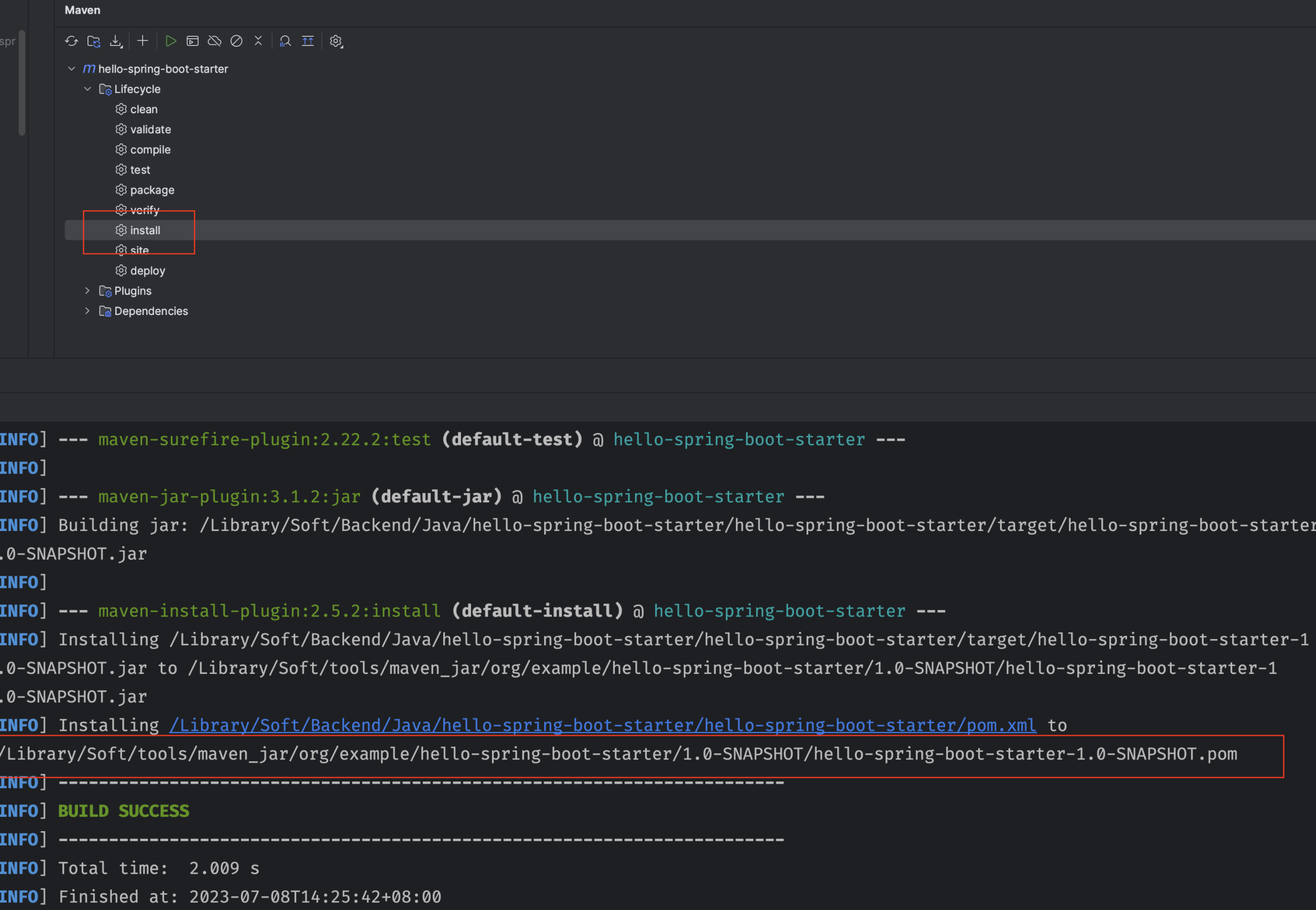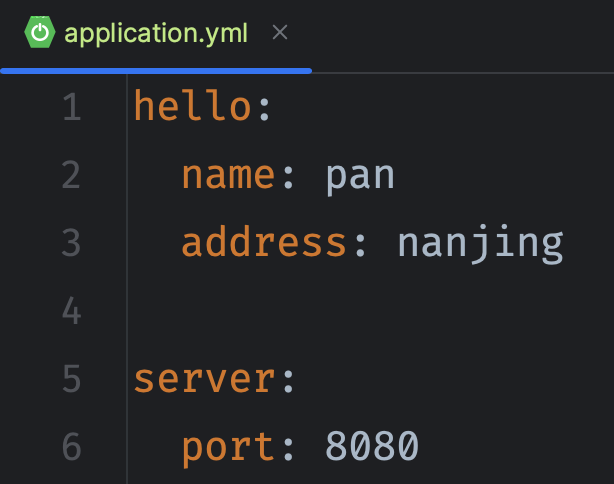通用許可權系統-Spring-Boot-Starter
2023-07-08 21:00:46
Spring-Boot-Starter
自定義Starter
案例一:讀取application.yml中的引數
1、建立
1、建立maven工程hello-spring-boot-starter

2、pom中新增依賴
<?xml version="1.0" encoding="UTF-8"?>
<project xmlns="http://maven.apache.org/POM/4.0.0"
xmlns:xsi="http://www.w3.org/2001/XMLSchema-instance"
xsi:schemaLocation="http://maven.apache.org/POM/4.0.0 http://maven.apache.org/xsd/maven-4.0.0.xsd">
<modelVersion>4.0.0</modelVersion>
<groupId>org.example</groupId>
<artifactId>hello-spring-boot-starter</artifactId>
<version>1.0-SNAPSHOT</version>
<properties>
<maven.compiler.source>8</maven.compiler.source>
<maven.compiler.target>8</maven.compiler.target>
<project.build.sourceEncoding>UTF-8</project.build.sourceEncoding>
</properties>
<parent>
<groupId>org.springframework.boot</groupId>
<artifactId>spring-boot-starter-parent</artifactId>
<version>2.2.2.RELEASE</version>
<relativePath/>
</parent>
<dependencies>
<dependency>
<groupId>org.springframework.boot</groupId>
<artifactId>spring-boot-starter</artifactId>
</dependency>
<dependency>
<groupId>org.springframework.boot</groupId>
<artifactId>spring-boot-autoconfigure</artifactId>
</dependency>
</dependencies>
</project>
3、建立HelloProperties
設定屬性類,用於封裝組態檔中設定的引數資訊
package org.example.config;
import org.springframework.boot.context.properties.ConfigurationProperties;
/**
* TODO 設定屬性類,用於封裝組態檔中設定的引數資訊
*
* @author ss_419
* @version 1.0
* @date 2023/7/8 13:55
*/
@ConfigurationProperties(prefix = "hello")
public class HelloProperties {
private String name;
private String address;
public String getName() {
return name;
}
public void setName(String name) {
this.name = name;
}
public String getAddress() {
return address;
}
public void setAddress(String address) {
this.address = address;
}
@Override
public String toString() {
return "HelloProperties{" +
"name='" + name + '\'' +
", address='" + address + '\'' +
'}';
}
}
4、建立HelloService
這個類用於對讀取到的引數進行一些業務上的操作
package org.example.service;
/**
* TODO
*
* @author ss_419
* @version 1.0
* @date 2023/7/8 14:03
*/
public class HelloService {
private String name;
private String address;
public HelloService(String name, String address) {
this.name = name;
this.address = address;
}
public String sayHello(){
return "你好!我的名字叫做"+name+",地址是" + address;
}
}
5、建立HelloServiceAutoConfiguration(用於自動設定HelloService物件)
package org.example.config;
import org.example.service.HelloService;
import org.springframework.beans.factory.annotation.Autowired;
import org.springframework.boot.autoconfigure.condition.ConditionalOnMissingBean;
import org.springframework.boot.context.properties.EnableConfigurationProperties;
import org.springframework.context.annotation.Bean;
import org.springframework.context.annotation.Configuration;
/**
* TODO 自動設定類
* 通過@Configuration + @Bean 實現自動建立物件
*
* @author ss_419
* @version 1.0
* @date 2023/7/8 14:06
*/
@Configuration
// 一定要加上這個註解,否則Spring找不到這個設定類
@EnableConfigurationProperties(value = HelloProperties.class)
public class HelloServiceAutoConfiguration {
private HelloProperties helloProperties;
// 通過構造方法注入設定屬性物件HelloProperties
public HelloServiceAutoConfiguration(HelloProperties helloProperties) {
this.helloProperties = helloProperties;
}
// 範例化HelloService並載入Spring IOC 容器
@Bean
@ConditionalOnMissingBean// Spring中沒有這個範例的時候再去建立
public HelloService helloService(){
return new HelloService(helloProperties.getName(), helloProperties.getAddress());
}
}
6、在resources目錄下建立META-INF/spring.factories
org.springframework.boot.autoconfigure.EnableAutoConfiguration=\
org.example.config.HelloServiceAutoConfiguration
7、將工程打包到maven倉庫中

2、使用
1、建立專案,匯入自定義starter

2、建立application.yml組態檔

3、建立啟動類
package org.example;
import org.springframework.boot.SpringApplication;
import org.springframework.boot.autoconfigure.SpringBootApplication;
/**
* TODO
*
* @author ss_419
* @version 1.0
* @date 2023/7/8 14:39
*/
@SpringBootApplication
public class HelloApplication {
public static void main(String[] args) {
SpringApplication.run(HelloApplication.class,args);
}
}
4、建立測試Controller
package org.example.controller;
import org.example.annotaion.MyLog;
import org.example.service.HelloService;
import org.springframework.beans.factory.annotation.Autowired;
import org.springframework.web.bind.annotation.GetMapping;
import org.springframework.web.bind.annotation.RequestMapping;
import org.springframework.web.bind.annotation.RestController;
/**
* TODO
*
* @author ss_419
* @version 1.0
* @date 2023/7/8 14:36
*/
@RestController
@RequestMapping("/hello")
public class HelloController {
@Autowired
private HelloService helloService;
@GetMapping("/sayHello")
public String sayHello() {
return helloService.sayHello();
}
}
5、測試

案例二:通過自動設定來建立一個攔截器物件,通過此攔截器物件來實現記錄紀錄檔功能
1、建立
1、建立maven專案並且引入依賴
<?xml version="1.0" encoding="UTF-8"?>
<project xmlns="http://maven.apache.org/POM/4.0.0"
xmlns:xsi="http://www.w3.org/2001/XMLSchema-instance"
xsi:schemaLocation="http://maven.apache.org/POM/4.0.0 http://maven.apache.org/xsd/maven-4.0.0.xsd">
<modelVersion>4.0.0</modelVersion>
<parent>
<groupId>org.springframework.boot</groupId>
<artifactId>spring-boot-starter-parent</artifactId>
<version>2.2.2.RELEASE</version>
<relativePath/>
</parent>
<groupId>org.example</groupId>
<artifactId>log-spring-boot-starter</artifactId>
<version>1.0-SNAPSHOT</version>
<properties>
<maven.compiler.source>8</maven.compiler.source>
<maven.compiler.target>8</maven.compiler.target>
<project.build.sourceEncoding>UTF-8</project.build.sourceEncoding>
</properties>
<dependencies>
<dependency>
<groupId>org.springframework.boot</groupId>
<artifactId>spring-boot-starter</artifactId>
</dependency>
<dependency>
<groupId>org.springframework.boot</groupId>
<artifactId>spring-boot-autoconfigure</artifactId>
</dependency>
<dependency>
<groupId>org.springframework.boot</groupId>
<artifactId>spring-boot-starter-web</artifactId>
</dependency>
</dependencies>
</project>
2、建立MyLog註解
package org.example.annotaion;
import java.lang.annotation.ElementType;
import java.lang.annotation.Retention;
import java.lang.annotation.RetentionPolicy;
import java.lang.annotation.Target;
@Target(ElementType.METHOD)
@Retention(RetentionPolicy.RUNTIME)
public @interface MyLog {
/**
* 方法描述
* @return
*/
String desc() default "";
}
3、建立紀錄檔攔截器
package org.example.interceptor;
import org.example.annotaion.MyLog;
import org.springframework.web.method.HandlerMethod;
import org.springframework.web.servlet.ModelAndView;
import org.springframework.web.servlet.handler.HandlerInterceptorAdapter;
import javax.servlet.http.HttpServletRequest;
import javax.servlet.http.HttpServletResponse;
import java.lang.reflect.Method;
/**
* TODO 自定義紀錄檔攔截器
*
* @author ss_419
* @version 1.0
* @date 2023/7/8 17:43
*/
public class MyLogInterceptor extends HandlerInterceptorAdapter {
private static final ThreadLocal<Long> startTimeThreadLocal = new ThreadLocal<>();// 記錄時間毫秒值
/**
* 執行之前
* @param request
* @param response
* @param handler
* @return
* @throws Exception
*/
@Override
public boolean preHandle(HttpServletRequest request, HttpServletResponse response, Object handler) throws Exception {
// 進行轉換
HandlerMethod handlerMethod = (HandlerMethod) handler;
Method method = handlerMethod.getMethod();
// 獲取方法上的註解MyLog
MyLog annotation = method.getAnnotation(MyLog.class);
if(annotation != null){
// 說明當前攔截到的方法上加入了MyLog註解
long currentTimeMillis = System.currentTimeMillis();
startTimeThreadLocal.set(currentTimeMillis);
}
return true;
}
/**
* 執行之後
* @param request
* @param response
* @param handler
* @param modelAndView
* @throws Exception
*/
@Override
public void postHandle(HttpServletRequest request, HttpServletResponse response, Object handler, ModelAndView modelAndView) throws Exception {
HandlerMethod handlerMethod = (HandlerMethod) handler;
Method method = handlerMethod.getMethod();
// 獲取方法上的註解MyLog
MyLog annotation = method.getAnnotation(MyLog.class);
if(annotation != null){
// 說明當前攔截到的方法上加入了MyLog註解
Long startTime = startTimeThreadLocal.get();
long endTime = System.currentTimeMillis();
long optTime = endTime - startTime;
String requestUri = request.getRequestURI();
String methodName = method.getDeclaringClass().getName() + "."+
method.getName()+"()";
String methodDesc = annotation.desc();
System.out.println("請求uri:"+requestUri);
System.out.println("請求方法名:"+methodName);
System.out.println("方法描述:"+methodDesc);
System.out.println("方法執行時間:"+optTime+"ms");
}
super.postHandle(request, response, handler, modelAndView);
}
}
4、建立自動裝配物件
package org.example.config;
import org.example.interceptor.MyLogInterceptor;
import org.springframework.context.annotation.Configuration;
import org.springframework.web.servlet.config.annotation.InterceptorRegistry;
import org.springframework.web.servlet.config.annotation.WebMvcConfigurer;
/**
* TODO
*
* @author ss_419
* @version 1.0
* @date 2023/7/8 18:08
*/
@Configuration
public class MyLogAutoConfiguration implements WebMvcConfigurer {
/**
* 註冊自定義紀錄檔攔截器
* @param registry
*/
@Override
public void addInterceptors(InterceptorRegistry registry) {
registry.addInterceptor(new MyLogInterceptor());
}
}
5、在resources下建立META-INF,在該資料夾下建立spring.factories
該組態檔用於掃描自動裝配類
org.springframework.boot.autoconfigure.EnableAutoConfiguration=\
org.example.config.MyLogAutoConfiguration
2、使用
1、建立一個web專案,並且引入依賴,pom.xml如下:
<?xml version="1.0" encoding="UTF-8"?>
<project xmlns="http://maven.apache.org/POM/4.0.0"
xmlns:xsi="http://www.w3.org/2001/XMLSchema-instance"
xsi:schemaLocation="http://maven.apache.org/POM/4.0.0 http://maven.apache.org/xsd/maven-4.0.0.xsd">
<modelVersion>4.0.0</modelVersion>
<groupId>org.example</groupId>
<artifactId>use-my-spring-boot-starter-demo</artifactId>
<version>1.0-SNAPSHOT</version>
<parent>
<groupId>org.springframework.boot</groupId>
<artifactId>spring-boot-starter-parent</artifactId>
<version>2.2.2.RELEASE</version>
<relativePath/>
</parent>
<properties>
<maven.compiler.source>8</maven.compiler.source>
<maven.compiler.target>8</maven.compiler.target>
<project.build.sourceEncoding>UTF-8</project.build.sourceEncoding>
</properties>
<dependencies>
<dependency>
<groupId>org.example</groupId>
<artifactId>log-spring-boot-starter</artifactId>
<version>1.0-SNAPSHOT</version>
</dependency>
<dependency>
<groupId>org.springframework.boot</groupId>
<artifactId>spring-boot-starter-web</artifactId>
</dependency>
<dependency>
<groupId>org.example</groupId>
<artifactId>hello-spring-boot-starter</artifactId>
<version>1.0-SNAPSHOT</version>
</dependency>
</dependencies>
</project>
2、建立測試Controller
在測試的方法上新增上自定義的MyLog註解,當該方法執行的時候就會在控制檯輸出對應資訊
package org.example.controller;
import org.example.annotaion.MyLog;
import org.example.service.HelloService;
import org.springframework.beans.factory.annotation.Autowired;
import org.springframework.web.bind.annotation.GetMapping;
import org.springframework.web.bind.annotation.RequestMapping;
import org.springframework.web.bind.annotation.RestController;
/**
* TODO
*
* @author ss_419
* @version 1.0
* @date 2023/7/8 14:36
*/
@RestController
@RequestMapping("/hello")
public class HelloController {
@Autowired
private HelloService helloService;
@GetMapping("/sayHello")
@MyLog(desc = "sayHello方法")
public String sayHello() {
return helloService.sayHello();
}
}
3、測試

到這裡,對於自定義starter的案例就結束了。